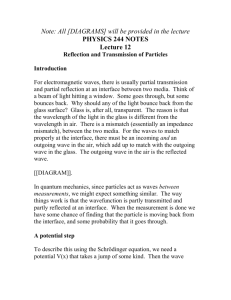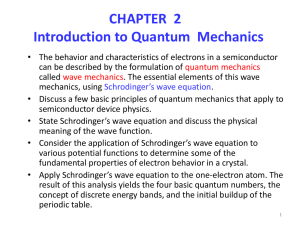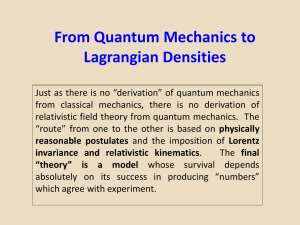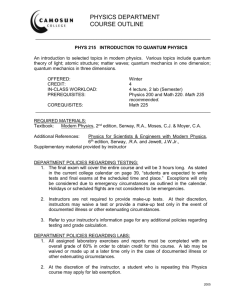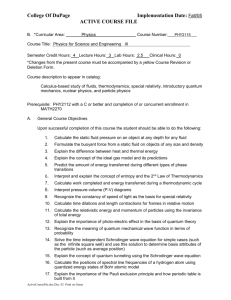REVIEW OF WAVE MECHANICS
advertisement
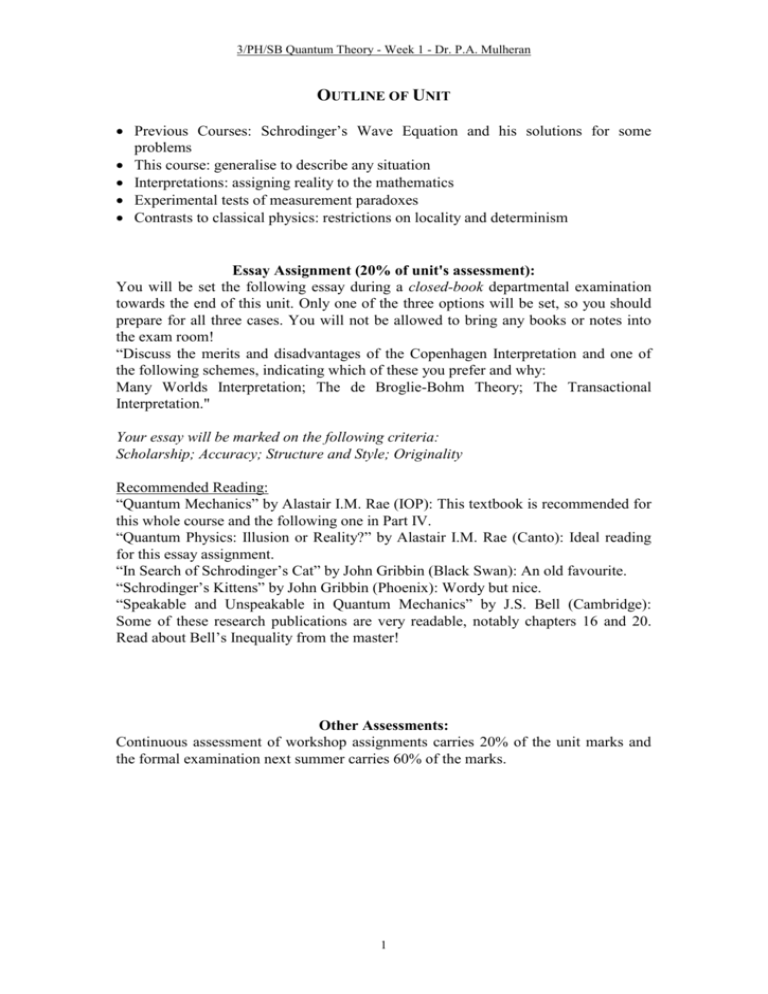
3/PH/SB Quantum Theory - Week 1 - Dr. P.A. Mulheran OUTLINE OF UNIT Previous Courses: Schrodinger’s Wave Equation and his solutions for some problems This course: generalise to describe any situation Interpretations: assigning reality to the mathematics Experimental tests of measurement paradoxes Contrasts to classical physics: restrictions on locality and determinism Essay Assignment (20% of unit's assessment): You will be set the following essay during a closed-book departmental examination towards the end of this unit. Only one of the three options will be set, so you should prepare for all three cases. You will not be allowed to bring any books or notes into the exam room! “Discuss the merits and disadvantages of the Copenhagen Interpretation and one of the following schemes, indicating which of these you prefer and why: Many Worlds Interpretation; The de Broglie-Bohm Theory; The Transactional Interpretation." Your essay will be marked on the following criteria: Scholarship; Accuracy; Structure and Style; Originality Recommended Reading: “Quantum Mechanics” by Alastair I.M. Rae (IOP): This textbook is recommended for this whole course and the following one in Part IV. “Quantum Physics: Illusion or Reality?” by Alastair I.M. Rae (Canto): Ideal reading for this essay assignment. “In Search of Schrodinger’s Cat” by John Gribbin (Black Swan): An old favourite. “Schrodinger’s Kittens” by John Gribbin (Phoenix): Wordy but nice. “Speakable and Unspeakable in Quantum Mechanics” by J.S. Bell (Cambridge): Some of these research publications are very readable, notably chapters 16 and 20. Read about Bell’s Inequality from the master! Other Assessments: Continuous assessment of workshop assignments carries 20% of the unit marks and the formal examination next summer carries 60% of the marks. 1 3/PH/SB Quantum Theory - Week 1 - Dr. P.A. Mulheran REVIEW OF WAVE MECHANICS 1.2 Schrodinger’s Equations Time Dependent Schrodinger Equation: 2 2 ( r , t ) V (r ) ( r , t ) i ( r , t ) 2 t (r,t) is the wave function of the particle; it is not a physical quantity but a mathematical one, there is nothing vibrating in space! = (reduced) mass, V(r) = potential energy of particle at position r. For a ‘closed’ system with definite energy E , (r , t ) u (r ) exp(it ) , where u(r) is the spatial part of the wave function. Time Independent Schrodinger Equation: 2 2 u(r ) V (r ) u(r ) E . u(r ) 2 Interpretation of wave functions The probability of finding the particle in the volume d around r is P(r )d * d | u(r )|2 d where the last relation holds for systems with definite energy E. It has been assumed that the wave functions are normalised, that is all the probabilities add up to unity: 2 | u(r )| d 1 . allspace Boundary Conditions Wave function u(r) is continuous (single-valued) so that probability is uniquely defined. The first derivatives u/x (etc.) are continuous where the potential V is finite, otherwise the total energy E diverges which is not physical. 2 3/PH/SB Quantum Theory - Week 1 - Dr. P.A. Mulheran 1.3 Particle in a box The Infinite Square Well: One dimension The particle is confined to a region of space 0 < x < L by walls of infinite potential, so that u(0) = u(L) = 0. The solutions are standing waves in the well: un ( x) 2 L sin(n x L) , n 1,2,3,... and the particle’s energy is quantised into discrete levels En 2 n2 2 . 2 L2 The infinite square well in higher dimensions Since the potential energy can be written as a sum of one-dimensional functions, the TISE is separable and the wave function can be written as the product of one dimensional functions. In this case n x 2 n y 2 n z un1n2 n3 ( x , y , z) 2 L sin( 1 ) sin( 2 ) sin( 3 ) L L 1 2 3 L1 L2 L3 Wells with finite walls The wave function oscillates in space when the total energy E > V(r), the local potential energy. However when E < V(r) solutions of the TISE require the wave function to decay or grow exponentially. Clearly if the particle is to remain bound inside its well, its wave function must only decay into the finite potential walls. Because the wave function and its first derivative are continuous here, only certain values of the total energy E produce these type of solutions; the energy levels are thus also quantised in these type of wells. 3 3/PH/SB Quantum Theory - Week 1 - Dr. P.A. Mulheran 1.4 The Simple Harmonic Oscillator Examples: atoms bound in molecules and solids The potential energy of the particle (in one dimension) as it is displaced a distance x from its equilibrium position is V ( x) 1 2 1 Kx 2 x 2 , 2 2 where the (angular) frequency of the oscillator solved using classical mechanics is K , K being the spring constant and the reduced mass. Schrodinger’s solution is that the energy levels of the bound states are 1 E n ( n ) , n 0,1,2 ,3..... 2 This solution explains the heat capacitance of solids and the vibrations of molecules. The ground state solution, n=0, does not have zero energy. The particle can never be stationary since this requires infinite kinetic energy, and instead the particle is said to have zero-point motion. The corresponding wave functions for this system are un ( x) Pn ( x).exp( x 2 ) , where the Pn(x) is a polynomial of order n (scaled versions of the Hermite polynomials) 4 3/PH/SB Quantum Theory - Week 1 - Dr. P.A. Mulheran 1.5 Hydrogen and Hydrogen-like Atoms Schrodinger also solved his equation for Hydrogen-like atoms, where a single electron moves in the electrostatic potential of the nucleus V (r ) Ze 2 , 4 0 r where Ze is the charge on the nucleus. From our previous work we know that only certain energies will provide bound state solutions. The TISE is written in spherical polar co-ordinates to utilise the symmetry of the atom: 1 ˆ2 1 ˆ2 L V ( r ) u ( r, , ) E u( r, , ) . 2 Pr 2 2r 2 Here Pˆr is the operator for the square of the radial momentum (it involves differentiation with respect to r but not or ) and L̂2 is the operator for the square of the total angular momentum. This equation is separable, so that the solution can be written as a product of three one-dimensional functions. The equation involving the angular momentum operator has the spherical harmonics as its solution: Ylm ( , ) Clm P |ml| (cos( )) exp(im ) . Here Clm is a normalisation constant and Pl m is the associated Legendre function. l and m are quantum numbers that label the possible solutions; l 0,1,2,3,... m l ,l 1,...l 1, l . The spherical harmonics are eigenfunctions of the L̂2 operator: L2 Ylm ( , ) l (l 1) 2 Ylm ( , ) Thus the square of the total orbital angular momentum of the electron in the atom is quantised. This results solely from the spherical symmetry of the system, and so all spherically symmetric systems have quantised angular momentum. Note the simple dependence of the spherical harmonics; this is related to the quantisation of the z-component of angular momentum, lz m , m 0,1,2.., l m l . 5 3/PH/SB Quantum Theory - Week 1 - Dr. P.A. Mulheran Writing the wave function as a product of a spherical harmonic and a function of r, u(r, ,) = R(r).Ylm(,), substituting into the TISE and simplifying we find 2 d 2 2 l (l 1) 2 . dr 2 V ( r ) 2 r 2 ( r ) E . (r ) , where (r) = r.R(r) is an effective radial wave function. This has the form of a simple one dimensional problem with a particle moving in a potential well defined by the sum of the Coulomb potential plus a centrifugal term due to the angular momentum when l > 0. The solutions to this equation require one extra quantum number n = l+1, l+2,… The fact that n > l is the only effect the centrifugal potential has on the energy of the solutions is remarkable, and is only true for the 1/r Coulomb potential. In other atoms where the nucleus is partially screened by the inner electrons, the potential seen by the outer electron is not of this simple form and the angular momentum does affect the allowed energy levels. The energy levels found by solving this equation with the requirement that the wave function (r) decays to zero exponentially as r increases are as in Bohr’s famous formula: En Z 2 e 4 . 2 ( 4 0 ) 2 2 n 2 The corresponding radial wave functions are of the form nl (r ) Fnl (r ) exp( Zr na ) , 0 where Fnl(r) is a polynomial of order n with (n-l-1) nodes, and a0 is the Bohr radius: 4 0 2 a0 . e2 6 3/PH/SB Quantum Theory - Week 1 - Dr. P.A. Mulheran WORKSHOP QUESTIONS Hand your solutions to the following questions to Dr. Mulheran at the start of the first workshop in week 2. Some of your solutions will be marked as part of the continuous assessment of this unit which contributes 20% of the overall module grade. Your solutions must be well presented; untidy work will be penalised. 1.1 (a) Consider the ground state solution of a particle in a one dimensional infinite square well. Write the time-dependent wave function as a sum of two travelling waves inside the well; how does this form of the wave function compare to the classical description of the particle inside the well? [3 marks] (b) Now estimate the uncertainty in the particle’s momentum. Is it reasonable to assume that the position-momentum uncertainty principle is obeyed in this system? [2 marks] 1.2 (a) A bead of mass can slide freely around a circular wire hoop of radius a. To describe this system in quantum mechanics we must write the TISE in the appropriate cylindrical co-ordinates and solve it using physical boundary conditions. The Lapacian operator in cylindrical co-ordinates is given by 1 1 2 2 . r r r r r 2 2 z 2 2 Now the bead cannot change its distance r from the origin, and has no zdependence, so only the middle term is nonzero in the TISE: 2 d 2 u( ) E. u( ) . 2 a 2 d 2 Solve this equation to find the functional form of the wave functions u(). [2 marks] (b) Impose the boundary condition that the wave function must be singlevalued, i.e. that u(+2) = u(). Hence derive the energy levels for this system. [3 marks] 1.3 A particle of mass moving in one dimension is attached by a spring (with spring constant K) to a wall at x=0. (a) What are the energy levels of this system? [2 marks] Hint: this situation is similar to the simple harmonic oscillator except that the wave function must be zero at the wall. (b) If the above particle is now free to move in three dimensions with x>0 derive its energy spectrum. [3 marks] Hint: use the fact that the TISE is separable into the three co-ordinates x, y and z, so that the wave function may be written as a product of three one dimensional waves which themselves are solutions of 1D harmonic oscillators. 7 3/PH/SB Quantum Theory - Week 1 - Dr. P.A. Mulheran 1.4 Show that the wave function Zr exp( Zr ( r ) C r 1 ) 2a 0 2a 0 satisfies the TISE for the radial part of the electron’s wave function in a Hydrogen-like atom (as given in the lecture notes), where the quantum numbers are n=2 and l=0. [5 marks] 8 3/PH/SB Quantum Theory - Week 1 - Dr. P.A. Mulheran WORKSHOP SOLUTIONS 1.1 (x , t ) 2 sin( kx ).exp(i t ) L i exp[i (kx t ] exp[i ( kx t )]) 2L where k=/L and w = E1/. This linear superposition of travelling waves represents the classical situation where the particle bounces back-and-forth inside the well without losing energy. The momentum of the particle is k, so the uncertainty delta p ~ k = /L. The uncertainty in the position delta x ~ L/2, so that the product ~ /2 > /2 as required by HUP. 1.2 Need functional form that when differentiated twice we get negative constants times original form. The complex exponential satisfies this (as does the sinusoidal), so u( ) C.exp(im ) . Now u(+2) = u() means exp(im2)=1, so that m must be an integer. Finally substituting this solution into the TISE we have Em 2 m2 , m = 0, +/-1, +/-2,... for the allowed energy levels of the 2 a 2 system. 1.3 (a) From the 1D simple harmonic solutions, the first, third, fifth…etc excited state wave functions are zero at the origin. Thus the x>0 parts are eigenfunctions of the given problem, so the energy levels are 1 E n1 n1 , n1 1,3,5... 2 (b) H ( x , y , z ) u ( x , y , z ) h1 ( x ) h2 ( y ) h3 ( z ) u ( x , y , z ) E . u ( x , y , z ) , where 2 2 1 2 h1 ( x ) Kx , etc. 2 x 2 2 Putting u = u1(x).u2(y).u3(z) into the TISE and dividing through by u we find 1 1 1 h1 u1 ( x ) h2 u 2 ( y ) h3 u 3 (z ) E . u1 (x ) u2 ( y) u3 (z ) Since each variable can vary independently, each group on the left must itself be equal to a constant, say E1, E2 and E3 respectively. Then h1 u1 (x ) E1 . u1 (x ) , etc., which is a one dimensional SH problem whose solutions we already know. Thus in total E E1 E 2 E 3 . (n1 n 2 n 3 3 / 2) , n1 1,3,5..., n 2 0,1,2,3..., n 3 0,1,2,3... 9 3/PH/SB Quantum Theory - Week 1 - Dr. P.A. Mulheran 1.4 2 d 2 2l (l 1) . V ( r ) (r ) En . (r ) 2 2 r 2 2 dr with n=2 and l=0. 4 0 2 Substituting in, and using a 0 , the LHS of the TISE becomes just e2 Z 2 e 4 which equals the RHS for E2. 8( 4 0 ) 2 2 10
